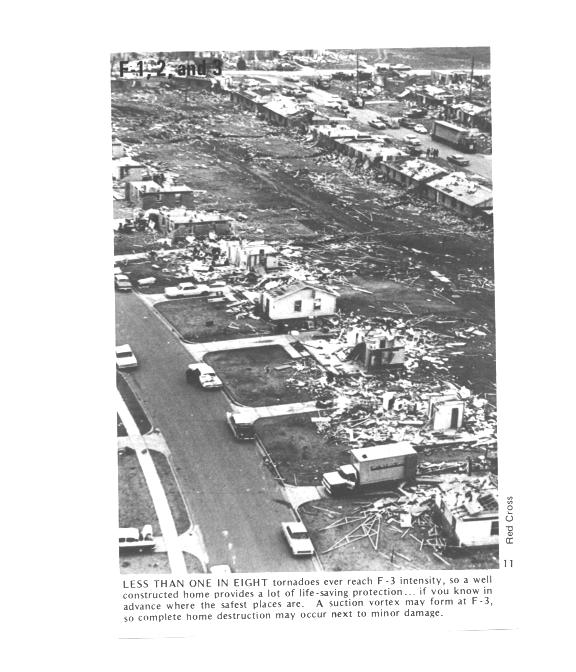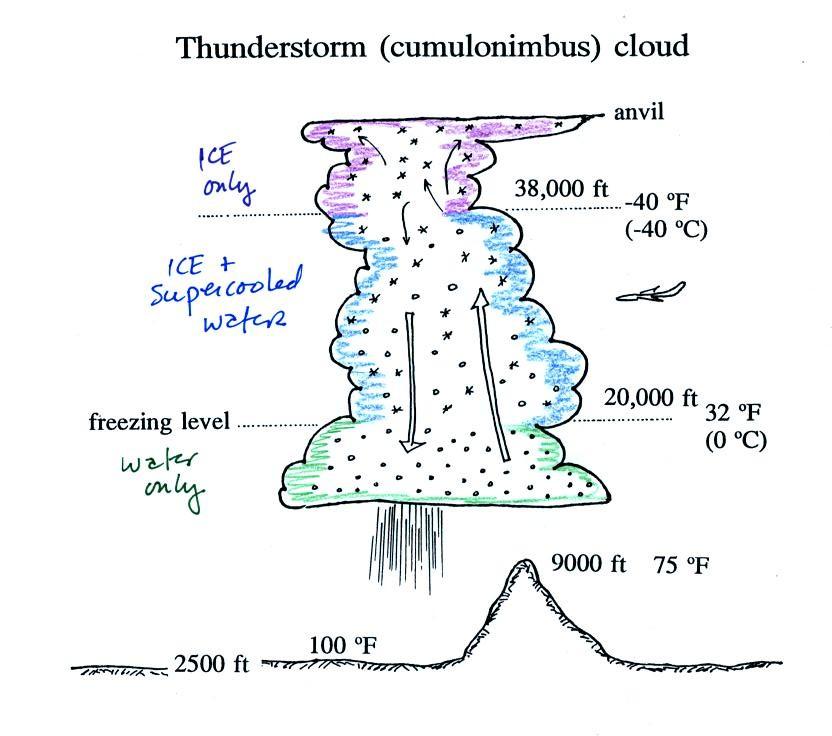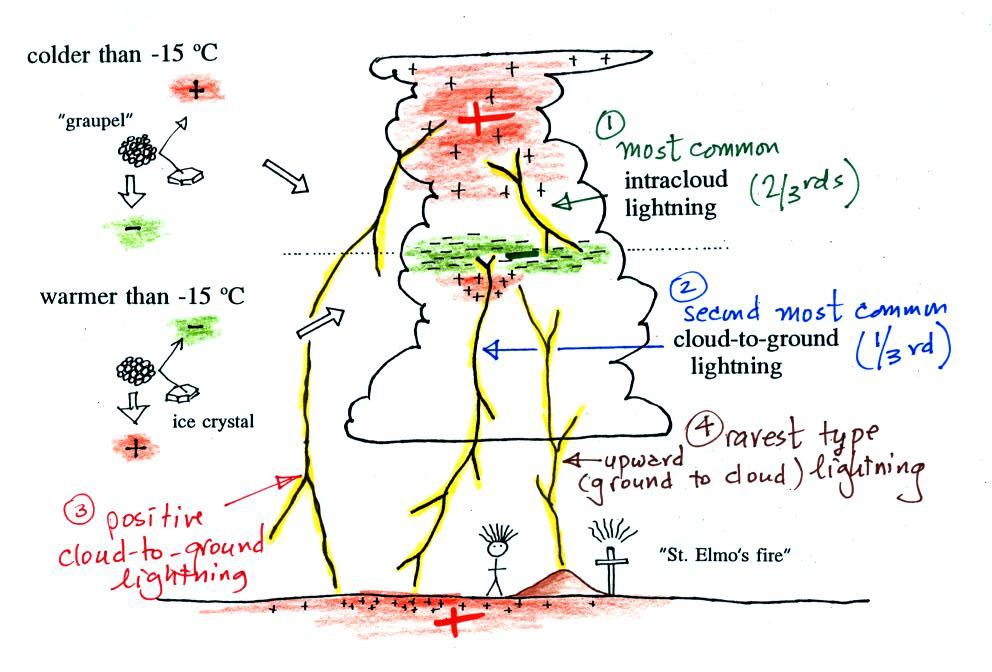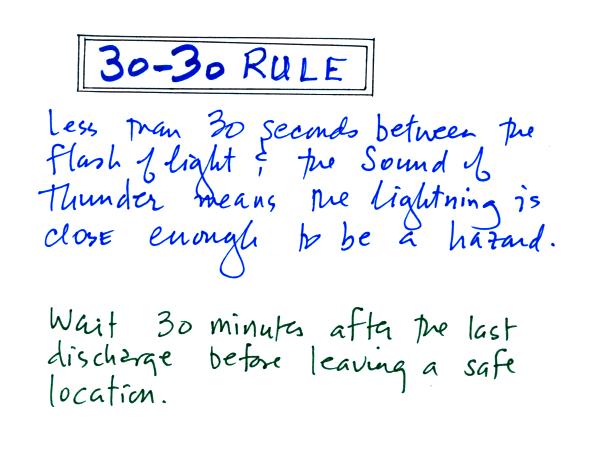Many cloud-to-ground flashes end at
this point. In
about 50% of cloud to ground discharges,
the stepped leader-upward
discharge-return stroke sequence repeats itself (multiple times) with a
few subtle
differences.
A downward dart leader travels from
the cloud to the
ground. The dart leader doesn't step but travels smoothly and follows
the channel created by the stepped leader (avoiding the
branches). It is followed by a slightly less powerful subsequent
return stroke that travels back up the channel to the cloud. This
second stroke might be followed by a third, a fourth, and so on.
Here are
some unusual types of lightning.
We've been looking at strikes that
originate in the negative charge center is a thunderstorm (discharge at
left in figure above). Occasionally a lightning
stroke will travel from the
positive charge
region in the top of the thunderstorm cloud to ground (shown at right
in the figure above). These
types of strikes are more common at the ends of storms and in winter
storms. This is probably because the top part of the cloud gets
pushed sideways away from the middle and bottom portions of the
cloud. Positive strokes are very powerful. They sometimes
produce an unusually loud and long lasting clap of thunder.

Note the
discharge is different in another way also. These
discharges are initiated by an upward leader. This is followed by
not by a return stroke, like you might expect, but by a more normal
downward leader. Once
the 2nd leader reaches the ground, an upward return stroke travels back
up the channel to the cloud.

The fact that lightning could begin
with an upward discharge that
begins at the ground led (French) scientists to develop a technique to
trigger
lightning by firing a small
rocket up
toward a thunderstorm. The rocket is connected by a thin wire to
the ground. When the rocket gets 50 to 100 m above the ground an
upward streamer will develop off of the top of the wire. Once the
streamer reaches the cloud it can initiate a "normal" series of
downward dart leaders and upward subsequent return strokes.
Scientists are able to take closeup photographs and make
measurements
of lightning currents using triggered lightning. Triggered
lightning can also be used to test the operation of lightning
protection devices. A short video showing rocket triggered
lightning experiments being conducted by University of Florida
scientists in northern Florida was shown in
class. There are also some good videos of the
experiments on YouTube.

When
lightning strikes the
ground
it will often melt the soil
(especially sandy soil) and leave behind a rootlike structure called a
fulgurite. A
fulgurite is just a narrow (1/2 to 1 inch across) segment of melted
sand (glass). The video showed archaeology students excavating
around the lightning triggering site after the summer's
experiments. They were able to uncover and reveal a very long
(perhaps world record length) fulgurite.
Lightning is a serious weather hazard. Here are some
lightning safety rules that you should keep in mind during
thundery weather.
Stay
away
from
tall
isolated
objects
during
a
lightning
storm.
You
can
be
hurt
or
killed
just
by
being
close
to
a
lightning
strike
even if you're
not struck directly. Lightning currents often travel outward
along the surface of the ground (or in water) rather than going
straight down into the ground. Just being close to something
struck by lightning puts you at risk.
An
automobile
with
a
metal
roof
and
body
provides
good
protection
from
lightning.
The
lightning
current
will
travel
through
the
metal
and around the passengers inside. The rubber tires really don't
play any role at all. The people in Florida that were
triggering lightning with rockets (shown on a video last week) were
inside a metal trailer and were perfectly
safe. All of the connections made to equipment outside the
trailer were done using fiber optics, there were no metal wires
entering
or leaving the trailer.
You shouldn't use a corded phone or electrical
appliances
during a lightning storm because lightning currents can follow wires
into your home. Cordless phones and cell phones are safe.
It is also a good idea to stay away from plumbing as much as possible
(don't take a shower during a lightning storm, for example). Vent
pipes that are connected to the plumbing go up to the roof of the
house which puts them in a perfect location to be struck.
To
estimate the distance to a lightning strike
count the
number of
seconds between the flash of light and when you first hear the
thunder. Divide this by 5 to get the distance in miles.
For example, a delay of 15 seconds between the flash of light and
the sound of thunder would mean the discharge was 3 miles away.
Research studies have shown that about 95% of cloud to ground
discharges strike the ground within 5 miles of a point directly below
the center of the storm. That's a 10 mile diameter circle and
covers the area of a medium size city.
The latest lightning safety recommendation is
the
30/30 Rule.
The 30/30 rule
People should seek shelter if the delay between
a lightning flash and its
thunder is 30 seconds or less.
People should remain under cover until
30 minutes after the final clap
of thunder.
The
following
information
wasn't
covered
in class and won't
be
on
this week's quiz
Some fairly new and unusual upper
atmospheric phenomena are sometimes called lightning. The figure below
(
source:
Wikipedia)
gives you an idea of where these so-called
sprites, elves,
and blue jets are found and sort of what they look like. They're
very faint and don't last very long so they difficult to see.
They don't really involve lighning channels and large currents like we
have been discussing. Rather these are phenomena most likely
caused by the electromagnetic fields produced by lightning.
You find some good actual pictures of sprites (mainly) at this sky-fire.tv
website. A
site maintained by the New Mexico Institute of Mining and
Technology (NM Tech) also has some good photographs, video, and more
information about these phenomena.
































